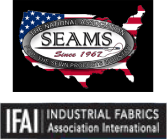Latest Posts
- Part 1 of 4 Series - Bow to Stern: Metal and Plastic Hardware Posted: 3/20/2019
- FR Treatments Explained Posted: 3/20/2019
- What is a DWR Treatment? Posted: 3/20/2019
- What Is Elastic and When Should You Use It? Posted: 3/20/2019
- Hook and Loop for Orthotics and Prosthetics Posted: 3/20/2019
Part 1 of 4 Series - Bow to Stern: Metal and Plastic Hardware
Posted: 3/20/2019
By: Terri Shadrix & Chad Thomas

Manufacturing for the marine industry has many obstacles that must be overcome to be successful. Marine environments are harsh and unforgiving due moisture, UV exposure and salt air. The key is to ensure that you are using the products with the correct finishes, resistant and specifications for your marine application.
In this Part 1 of 4 in this blog series covering manufacturing for the marine environment; we will be highlighting attributes of different metal and plastic hardware options that are best suited to this arena.
Metal Hardware
Material
Stainless steel is the ideal metal for the marine arena. Stainless steel is strong, does not rust and does not require polishing; ideal for moisture exposure. Stainless steel 316 and 304 are the preferred and reliable stainless alloys for marine use.
· 316 – This grade of stainless is typically used for marine applications. While it contains the same amount of chromium as 304 it has a higher percentage of nickel with an additional 2-3% molybdenum which increases the metal’s resistance to salt.
· 304 – This grade is the most common used of the 300 series stainless steel. Its alloy metal consists of 18% chromium and 8% nickel. 304 stainless is physically durable and aesthetically pleasing.
Because of stainless steel’s performance advantages, it does come at a higher price point.
Solid Brass is also another quality material which is mold poured for metal hardware parts. Solid brass has a history of being used in wooden naval hulls sheathing, navigation tools and marine pumps and engines. Brass is hard, tough and corrosion resistant even with exposure to salt water. Brass is created from copper and zinc and is incredible durable once oxidize. While solid brass is strong, and long lasting these rewards again come at a higher price point
While both stainless steel and solid brass are higher in cost the reliability, stability and longevity make both materials worth the investment for marine applications.
Finishes
As with the metal material finishes for a marine application are limited due the stress of the environment.
Hot Dipped Zinc (Special Zinc) is an option that can withstand salt spray test as well as a cadmium finish but with the benefit of being environmentally friendly
Cadmium- is a finish that is similar in color to zinc is excellent salt spray test and is rust resistant. However, its environmental footprint is extremely harmful, and it is VERY expensive. This finish is primarily designated to the aerospace industry.
If you choose a quality material such as stainless steel (316 or 304) or solid brass the need for a hearty and costly finish maybe eliminated but with a substantial material cost. One would have to investigate on which path would provide be most cost effective, quality assured and performance guarantee. Either superior base material or finish.
Zinc and nickel plating are fairly common and inexpensive finishes however, neither are not ideally suited for a marine application as they will rust and breakdown.
Plastic Hardware
Acetyl is the ideal option for salt-water setting compared to nylon plastic.
Acetyl strength characteristics for marine use:
· Strong
· Long wearing performance is both wet and dry environments
· Little Friction
· Quality chemical resistance
Nylon Plastic characteristic that make in NOT ideal for marine use:
· High moisture absorption losing up to 30% of its tensile strength due to this moisture absorption
· Requires UV treatment
Choosing quality, strong, and long-lasting elements for your marine products is key to the overall success and reputation of your business.
Contact DirecTex to learn more about our product lines. DirecTex specializes in custom manufactured components and subassemblies for your projects.




